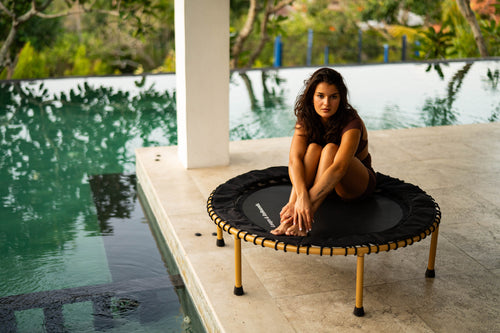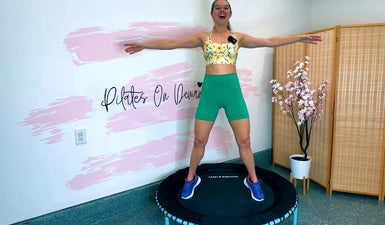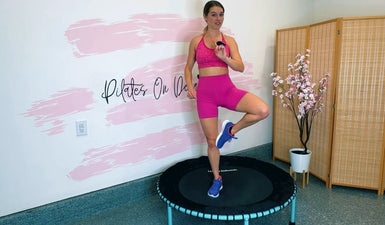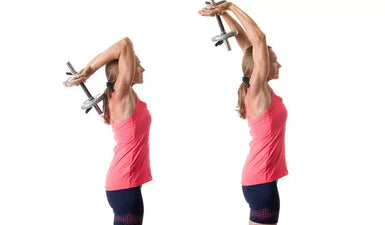Building impressive arms isn't just about focusing on biceps; the triceps actually make up a larger portion of your upper arm mass and are key for overall arm size and strength. Fortunately, you don't need a fancy gym to get great results. Dumbbells are incredibly versatile and accessible, making them a top choice for anyone looking to sculpt their triceps effectively, whether you're working out at home or at the gym. This guide will walk you through the best exercise for triceps with dumbbells to help you achieve your arm goals.
Key Takeaways
- Dumbbells offer a flexible way to target all three heads of your triceps, promoting balanced arm development.
- Exercises like overhead extensions and kickbacks are excellent for isolating and building triceps mass.
- Using single-arm dumbbell movements can help correct strength imbalances between your arms.
- To keep seeing progress, gradually increase the weight, reps, or sets over time.
- Focus on controlled movements through the full range of motion for the most effective and safe triceps workouts.
Understanding Triceps Anatomy for Targeted Growth
So, you want bigger arms, right? Well, a huge chunk of that comes from your triceps. They're the muscles on the back of your upper arm, and they're made up of three distinct parts, or heads. Think of them like a team, each with a slightly different job, but all working together to straighten your arm.
The Three Heads of the Triceps
Let's break 'em down:
- Long Head: This one's the biggest. It starts up near your shoulder blade, which means it helps out a bit with moving your arm backward too, not just straightening the elbow. This is a big reason why it adds a lot to overall arm size.
- Lateral Head: You can usually see this one on the outside of your arm, giving it that horseshoe look when you're really developed. It's pretty much all about elbow extension.
- Medial Head: This one sits deeper, closer to your bone, underneath the other two. It's active in almost every triceps movement, but it's often the first to fatigue.
Why Targeting All Heads Matters
If you only work one or two of these heads, your triceps won't look as full or be as strong as they could be. It's like having a sports team where only half the players show up – you're not going to perform your best. For that really complete, powerful look and function, you've got to give all three heads some attention. Neglecting one can lead to imbalances, and nobody wants that. We're aiming for balanced development here, which also helps with preventing injuries down the line.
Building impressive triceps isn't just about aesthetics; it's about creating a strong, functional upper body. Each head contributes differently, and hitting them all ensures your arms are not only visually appealing but also capable of handling everyday tasks and athletic movements with ease.
How Dumbbells Aid Anatomical Focus
This is where dumbbells really shine. Because you can work one arm at a time with dumbbells, you can really focus on what each muscle is doing. This is called unilateral training. It's super helpful if one arm is a bit weaker than the other, letting you bring them closer to equal strength. Plus, dumbbells allow for a more natural range of motion in many exercises compared to barbells or machines, which can help you feel the target muscle working better. This makes them a great tool for making sure you're hitting all those triceps heads effectively.
The Versatility of Dumbbells for Arm Sculpting

Dumbbells are pretty much the MVP of home and gym workouts. You can do so many different things with them, and they don't take up much space. For your triceps, this means you can perform exercises that target each of the three heads effectively. Think about it: you can do overhead movements, presses, extensions, and kickbacks, all with just a pair of dumbbells. This variety keeps your muscles guessing and prevents plateaus. Plus, using dumbbells forces your stabilizing muscles to work harder, leading to more functional strength.
Dumbbells for Home and Gym Workouts
One of the biggest wins with dumbbells is their adaptability. Whether you've got a dedicated home gym setup or are squeezing in a workout at a busy commercial gym, dumbbells are your go-to. They're compact, easy to store, and don't require a complex setup. This means you can consistently hit your triceps routine without needing a lot of equipment. You can achieve toned arms quickly using exercises that utilize 3-pound dumbbells or just your body weight.
Variety in Dumbbell Triceps Movements
The sheer number of exercises you can do with dumbbells for triceps is impressive. You're not limited to just one or two moves. This variety is key for continuous muscle growth and preventing your body from getting too used to the same old routine. Different angles and movement patterns stimulate the muscle fibers in new ways, leading to better development.
Here are just a few types of movements you can incorporate:
- Overhead Extensions
- Kickbacks
- Presses (like close-grip variations)
- Rows (which also engage triceps)
Engaging Stabilizing Muscles with Dumbbells
When you lift a dumbbell, especially compared to a machine, your body has to work harder to keep things stable. This means those smaller, often overlooked, stabilizing muscles around your shoulder, elbow, and even your core get a workout too. For your triceps, this translates to more balanced development and improved functional strength – the kind of strength that helps you in everyday activities, not just in the gym.
Working with free weights like dumbbells requires more coordination and control. This increased demand on your neuromuscular system can lead to greater overall muscle activation and a more robust strength foundation.
Mastering Key Dumbbell Triceps Exercises
Alright, so you're ready to really get into the nitty-gritty of building those triceps with dumbbells. It's not just about picking up weights; it's about knowing which moves hit which parts of your triceps best. Dumbbells are awesome because they let you move more freely than machines, and you can work each arm separately, which is a big deal for getting things balanced.
Dumbbell Overhead Triceps Extension Variations
This is a go-to for really stretching out and working the long head of your triceps. You can do it with one dumbbell held in both hands, or even better, switch to single-arm versions to make sure both sides are pulling their weight.
- Two-Handed Overhead Extension: Stand or sit, hold a dumbbell above your head with both hands. Keep your elbows tucked in close to your head. Lower the weight behind you by bending your elbows, then push it back up, squeezing your triceps hard at the top.
- Single-Arm Overhead Extension: Grab one dumbbell in one hand. Extend your arm straight up. Now, keeping your upper arm glued to your side, bend your elbow and lower the dumbbell behind your head. Straighten your arm to lift it back up. This is fantastic for spotting any weaknesses on one side.
Remember, the key here is to keep your upper arms as still as possible. The movement should come from your elbows bending and straightening. Don't let your shoulders do the work.
Dumbbell Kickbacks for Lateral and Long Head Activation
Don't underestimate the humble kickback! It's a great exercise for really isolating the triceps, especially the lateral head.
- Start by hinging at your hips, keeping your back straight and a dumbbell in each hand. Your upper arms should be parallel to the floor, with your elbows bent at about 90 degrees.
- From here, extend your forearms straight back, squeezing your triceps.
- Slowly return to the starting position.
Focus on a controlled movement, not just flinging the weights. You want to feel that squeeze at the end of the extension.
Lying Dumbbell Triceps Extensions (Skull Crushers)
This one's a classic for a reason. When done right, it really hammers all three heads of the triceps.
- Lie down on a bench or the floor. Hold a dumbbell in each hand, arms extended straight up above your chest.
- Keeping your upper arms vertical, lower the dumbbells towards your forehead by bending your elbows.
- Pause briefly, then extend your arms back to the starting position, squeezing your triceps.
Be careful with this one; it's easy to let your elbows flare out too much or drop the weights too fast. Keep it controlled.
Close-Grip Dumbbell Press for Medial Head Emphasis
While it looks like a chest exercise, a close-grip dumbbell press can be a killer for your triceps, particularly the medial head.
- Lie on a bench and hold dumbbells with a neutral grip (palms facing each other), close to your chest.
- Press the dumbbells straight up, keeping them close together.
- Lower them back down with control.
This variation puts more emphasis on the triceps compared to a standard dumbbell press. You'll feel the burn in the back of your arms.
| Exercise | Primary Triceps Head Targeted | Key Benefit |
|---|---|---|
| Overhead Extension (Two-Handed) | Long Head | Full stretch and contraction |
| Overhead Extension (Single-Arm) | Long Head | Corrects imbalances, focused work |
| Kickbacks | Lateral Head | Isolation, definition |
| Lying Extensions | All Heads | Compound movement for triceps |
| Close-Grip Press | Medial Head | Strength and mass builder for the inner head |
Benefits of a Focused Triceps Dumbbell Workout
So, you're hitting those triceps with dumbbells. That's smart. It's not just about getting bigger arms, though let's be honest, that's a pretty cool outcome. Stronger triceps actually help you out a lot in other areas, like when you're doing bench presses or overhead presses. They're like the silent partners that make those bigger lifts possible. Plus, having well-developed triceps can help keep your elbows and shoulders feeling more stable, which is good for preventing those annoying injuries that can sideline you.
Beyond Bigger Arms: Functional Strength
Working your triceps with dumbbells does more than just add size. It builds real, usable strength. Think about everyday tasks – pushing doors open, carrying groceries, or even just getting up from a chair. Your triceps are involved in all of that. When you focus on them with dumbbells, you're improving your ability to push things away, which is a pretty basic but important human movement. It translates to better performance in the gym too, making those compound lifts feel a bit easier.
Convenience and Accessibility of Dumbbell Routines
One of the best parts about using dumbbells for your triceps is how easy it is to fit into your life. You don't need a fancy gym setup. A couple of dumbbells and a little space are all you really need. You can get a solid workout done at home, in a hotel room if you're traveling, or of course, at the gym. It cuts down on the excuses, doesn't it? This accessibility means you can be more consistent, and consistency is what really builds muscle and strength over time.
Preventing Injuries with Stronger Triceps
Your triceps aren't just for show; they play a big role in stabilizing your elbow and shoulder joints. When these muscles are strong and balanced, they provide better support for your arm during movement. This can help reduce the stress on your joints, making them less prone to strains or sprains. It's like giving your arm a built-in support system, which is always a good thing, especially as you get older or if you're pushing heavy weights.
Focusing on your triceps with dumbbells means you're building strength that helps with daily activities and protects your joints. It's a practical approach to fitness that pays off in more ways than just aesthetics. Consistency with these exercises can lead to noticeable improvements in both form and function.
Structuring Your Ultimate Dumbbell Triceps Routine

Alright, so you've got the exercises down, but how do you actually put them together into a workout that gets results? It's not just about doing a bunch of reps; it's about being smart with your training. A well-planned routine is key to seeing those triceps grow and get stronger. You can build a simple, effective tricep routine using just dumbbells.
Sample Dumbbell Triceps Workout Plan
Here’s a straightforward routine you can try. Remember, this is just a template, and you should adjust it based on how you feel and your own fitness level. Consistency is more important than perfection. This kind of structured approach can be applied to a 3-day full-body dumbbell workout as well.
| Exercise | Sets | Reps |
|---|---|---|
| Overhead Dumbbell Extension | 3 | 10–12 |
| Dumbbell Kickbacks | 3 | 12–15 |
| Lying Dumbbell Triceps Extensions | 3 | 10–12 |
| Close-Grip Dumbbell Press | 3 | 8–10 |
| Single-Arm Overhead Extension | 2 | 12 (each arm) |
Rest Periods for Optimal Recovery
For muscle growth (hypertrophy), keep your rest periods between 30 to 60 seconds. This range is usually enough time to recover slightly without letting your heart rate drop too much, keeping the intensity up. Shorter rests can increase the metabolic stress, which is also a driver of muscle growth, while longer rests allow for better recovery between sets, potentially enabling you to lift heavier weights. It’s a balance you’ll find with practice.
Choosing the Right Weight for Each Exercise
Pick weights that feel challenging by the last couple of reps, but don't let your form suffer. The goal is to feel a strong burn and fatigue in your triceps by the end of each set, not to struggle so much that your technique breaks down. If you can easily do more reps than listed, the weight is too light. If you can't reach the lower end of the rep range with good form, it's too heavy. It’s better to use a slightly lighter weight with perfect form than to risk injury with bad form. Listen to your body and don't be afraid to scale back if needed.
When you're pushing yourself with these advanced techniques, remember that form is everything. It's better to use a slightly lighter weight with perfect form than to risk injury with bad form. Listen to your body and don't be afraid to scale back if needed.
Progressive Overload Strategies for Continuous Gains
So, you've been hitting those dumbbell triceps exercises, and things are feeling good. That's awesome! But to keep seeing those gains, you can't just do the same thing forever. You gotta push yourself a little, you know? It's all about making your muscles work harder over time. This is where progressive overload comes in, and it's not as complicated as it sounds. Building bigger triceps isn't just about lifting heavy. It's about consistently challenging your muscles in new ways. Think about how you can make each workout slightly tougher than the last, even if it's just by one rep or a few extra pounds. This steady progression is what leads to real, lasting muscle growth and strength gains.
Increasing Weight for Greater Challenge
This is the most obvious way to progress. Once you can comfortably hit the top end of your rep range for all your sets with good form, it's time to go a little heavier. Don't jump up too much; add just enough weight to make those last few reps feel tough again. For example, if you were doing 10 reps of overhead extensions with 15 pounds and it felt manageable, try 17.5 or 20 pounds next time and aim for 8-10 reps.
Adding Reps to Enhance Endurance
If you're not quite ready to increase the weight, or you want to focus on building more muscular endurance, try adding a couple of extra reps to each set. If your target is 10-12 reps and you're hitting 12 easily, push for 13 or 14 on your next workout. This keeps the intensity up without needing heavier dumbbells.
Adjusting Sets for Increased Volume
Another solid strategy is to add an extra set to one or two of your exercises. If you're typically doing 3 sets of lying triceps extensions, try bumping it up to 4 sets. This increases the total amount of work your triceps have to do, providing a new stimulus for growth.
Decreasing Rest Time
Shortening the rest periods between your sets can also make your workout more intense. Instead of resting for 60 seconds, try cutting it down to 45 or even 30 seconds. This makes the workout more metabolically demanding and can help push past plateaus.
Maximizing Time Under Tension
Don't forget about controlling the weight throughout the entire movement. The eccentric phase, or the lowering part of the lift, is super important. Try to lower the dumbbell slowly and with control, taking about 2-3 seconds. This increases the time your muscles are working and can lead to more muscle damage, which is what your body repairs and builds back stronger. It's a simple change that can really boost your results without needing to constantly chase heavier weights.
Remember, consistency is key. It's better to make small, consistent increases over time than to try and do too much too soon. Listen to your body and adjust as needed.
Addressing Imbalances With Unilateral Dumbbell Work

We all have a dominant side, right? It's just how our bodies work. This often means one arm might be a little stronger or even look a bit bigger than the other. It's super common, but it's something we can fix with the right approach. That's where working one arm at a time, or unilateral training, really shines.
The Power of Single-Arm Exercises
When you use dumbbells, you can easily switch to working just one arm. This lets you give that arm your full attention. Think about doing a single-arm overhead extension or a dumbbell kickback. You can really focus on the squeeze and make sure that arm is doing its fair share of the work. It's like giving your weaker side a chance to catch up without the stronger side taking over.
- Focus on Form: You can concentrate on perfect form for each rep, ensuring the target muscle is fully engaged.
- Equalize Strength: By working each arm independently, you can directly address and correct strength differences.
- Mind-Muscle Connection: It's easier to really feel the muscle working when you're not splitting your focus between two limbs.
Achieving Symmetry and Balanced Development
Constantly working both arms at the same time, like with a barbell, can sometimes make existing imbalances worse. Your stronger arm might just do more of the work without you even realizing it. Unilateral dumbbell work helps to level the playing field. It ensures that both your left and right triceps are getting the same stimulus, leading to more even growth and a more balanced look. This isn't just about aesthetics, though; it's about building a more functional and capable physique overall.
Reducing Injury Risk Through Balanced Training
When one side of your body is significantly stronger than the other, it can throw off your entire kinetic chain. This can lead to compensation patterns, where other muscles have to work harder to make up for the difference. Over time, this can increase your risk of strains or other injuries. By using single-arm dumbbell exercises to create symmetry, you're building a more stable and resilient body. It's a simple step that pays off big time in the long run for your training and overall health.
It's easy to overlook small differences between your arms, but addressing them proactively can make a big difference in your long-term progress and injury prevention. Don't let one side lag behind; give them both the attention they deserve.
When you want to make sure both sides of your body get an equal workout, using just one dumbbell at a time is a great way to go. This method helps you focus on each arm individually, preventing one side from doing more work than the other. It's a simple trick to keep your strength balanced. Want to learn more about different workout techniques? Visit our website for tons of great tips and routines!
Keep Building Those Arms
So, we've covered why hitting your triceps is a big deal for arm size and how dumbbells are a great way to do it. Remember those exercises we went through, like the overhead extensions and kickbacks? They're solid choices for really working the back of your arms. Just focus on using good form, don't rush to lift too heavy too soon, and give your muscles enough time to recover between workouts. Stick with it, and you'll start seeing and feeling the difference in your arms before you know it. Now go get those gains!
Frequently Asked Questions
Why are triceps important for arm size?
Even though many people focus on biceps, your triceps actually make up a bigger part of your upper arm. Training them properly is key to getting bigger, more shapely arms.
What are the benefits of using dumbbells for triceps workouts?
Dumbbells let you move your arms more freely, which can help you work your muscles better. They also let you train each arm separately to fix any strength differences and can be easier on your joints.
Which dumbbell exercises are best for triceps?
Great exercises include overhead dumbbell extensions, dumbbell kickbacks, and lying dumbbell extensions (also called skull crushers). These hit all three parts of your triceps.
How can dumbbells help with muscle imbalances?
By doing exercises one arm at a time with dumbbells, you can make sure both arms are working equally. This helps build balanced strength and makes your arms look more symmetrical.
How often should I do dumbbell triceps workouts?
It's good to train your triceps a couple of times a week, but make sure you give them enough time to rest and recover between workouts. Listen to your body!
What's the best way to keep making progress with dumbbell triceps exercises?
To keep getting stronger, you need to gradually make your workouts harder. You can do this by lifting a little more weight, doing more repetitions, or adding more sets over time.
























0 comments